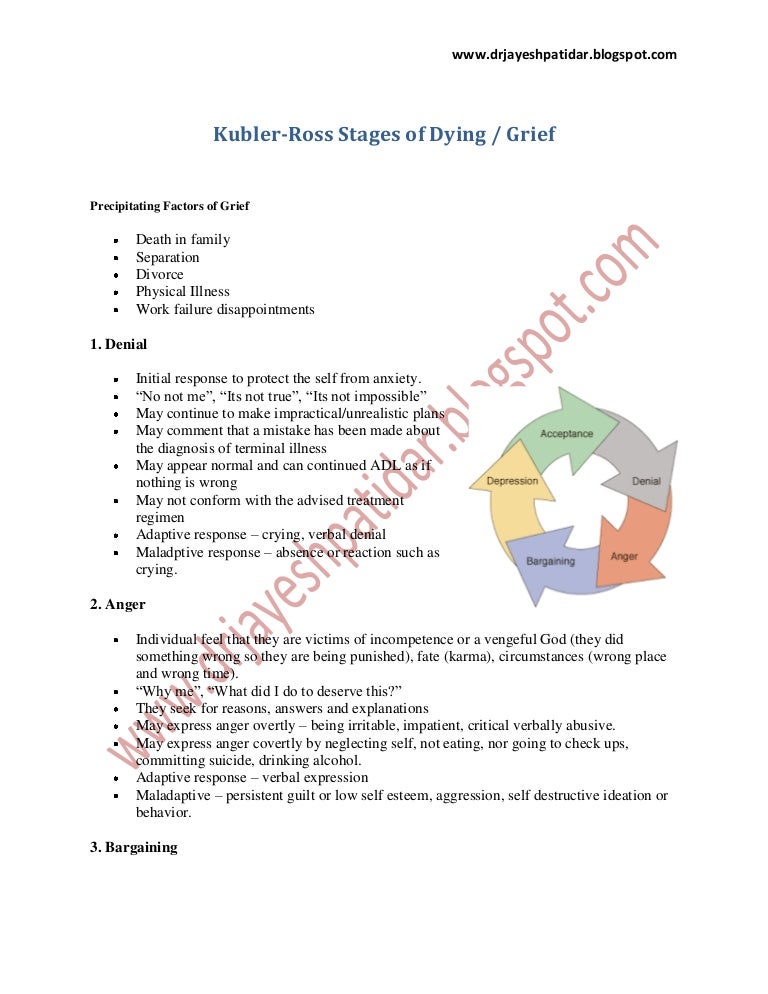Physical Stages of Dying. Pallor Mortis Algor Mortis Rigor Mortis and Livor Mortis.
 Kubler Ross Stages Of Dying Grief
Kubler Ross Stages Of Dying Grief
It could take place instantaneously or it could be a slow form of illness which takes months and sometimes years.

Physical stages of dying. The physical stages of dying are as follows. Assume that the patient can hear everything. If you have questions about hospice call us at 702 509-5276 or contact us online.
The pre-active phase of dying and the active phase of dying On average the pre-active phase of dying may last approximately two weeks while on average the active phase of dying lasts about three days. This is a physical and spiritual response to the dying process. Next they cannot accept the fact that the illness could affect them denial.
Areas of the body such as toenails fingernails elbows hands knees ankles legs back and buttocks become blotchy and more bluish or purple in color. Changes in blood pressure breathing and heart rate Body temperature ups and downs that may leave their skin cool warm moist or pale Congested breathing from the buildup in the back of their. Elisabeth K ue bler-Ross described the following stages of grief related to dying.
You may find prayers or meditation helpful at this time. In slow dying the physical stages are more pronounced. A point to remember is that not everyone will suffer from these symptoms but most of them are very common.
There are 4 stages. As the body shuts down energy needs decline. Dropping body temperature A drop in body temperature may mean there is very little blood flowing to the hands.
The skin hands and feet turn bluish due to lack of oxygen and blood circulation. When a person enters the final stage of the dying process two different dynamics are at work which are closely interrelated and interdependent. As their caregiver watching their journey through the stages of dying may be difficult but we hope that you gain closure as you understand what to expect when your loved one is possibly ready for home hospice care in Las Vegas.
Weakness in the limbs. 7 Signs that Death May Be Near. Appear to be in two worlds at once.
Physiological death occurs when the vital organs no longer function. Physical symptoms of dying will vary from person to person but there are several signs to look out for as someone becomes closer to death. Touch gently but only if the patient likes to be touched.
There are two phases which arise prior to the actual time of death. The body starts stiffening due to a phenomenon known as rigor mortis after around 3-5 hours of death. Inability to hear things clearly.
The eyes begin sinking into the skull. After we die there are 4 stages of changes that occur in the body. In the days before a person dies their circulation reduces so that blood is focused.
At first glycogen is broken down into glucose. On the physical plane the body begins the final process of shutting down which will end when all the physical systems cease to function. Their pulmonary system will start to degrade and the will become congested leading to a tell-tale death rattle Their breathing will also exhibit fluctuations as they may begin to respirate up to 50 times per minute or as little as six.
These 11 signs may indicate that death is near. Experiencing physical pain ranging from mild to extreme. The digestive and respiratory systems begin to shut down during the gradual process of dying.
Feeling exhausted and wanting to rest. Death is a fact of life that everyone will go through one day and the following are the 10 most fascinating stages ones body experiences immediately following death if the body is exposed to a natural decay and not preserved by processes such as embalming. Your loved one may start to refuse foods that are hard to chew or digest like meat.
All the blood of the body gathers at the lowest parts making them appear darkish purple. Do not ask questions which require answers. The third phase happens only in prolonged starvation and may end in the persons death.
Declining meals or simply taking a few bites is common. Sleeping more decreased appetite being less social changes in vital signs decreased body waste cool skin muscle weakness labored breathing. Those at the end of life may seem to be in two worlds at once.
Once death occurs in a body it undergoes a series of changes that occur in a timely and orderly manner. During the first stage of starvation blood glucose levels are maintained through the production of glucose from proteins glycogen and fats. Congestion can become very loud.
A dying person no longer wants to eat as digestion slows and the digestive track loses moisture and chewing swallowing and elimination become painful processes. In the days before death a series of physiological changes will occur. Dynamics of the Dying Process Physical Signs.
Physical Stages Of Dying Dying is a complete shut down of the physical sensory and mental functions of the body. Death is one of the most fundamental facts of life. Having a hard time breathing.
This stage will last for around 2 weeks after which the person will reach the physical stages of dying. Shock denial anger bargaining depression acceptance and decathexis. When individuals and their relatives first receive the news of a fatal disease they are shocked.
The First Phase of Starvation. Some may feel nauseous and lose their appetite. This can be a very emotionally upsetting time for the family.
Signs and Symptoms Of Approaching Death.